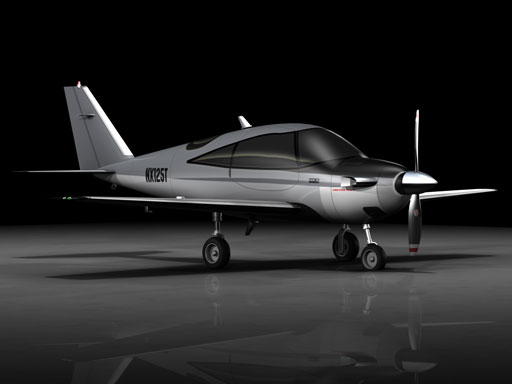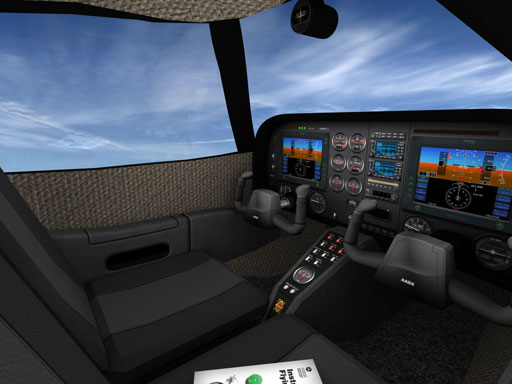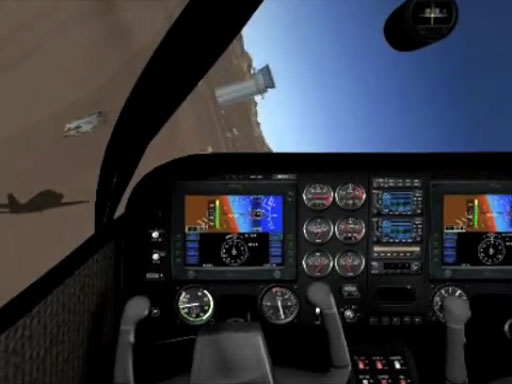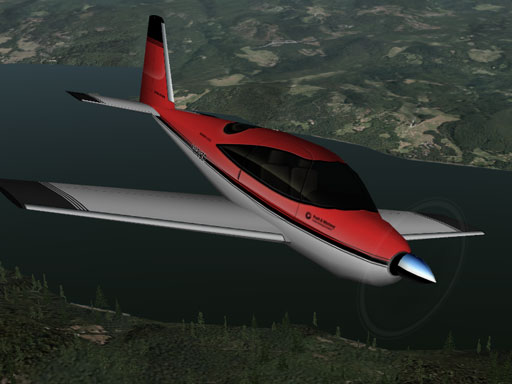


2010 AADX HAWK IIX.V 9X
I'm very pleased to roll out this very pleasant resurrection of an old friend. There is much history behind this model, and a long story in between then, now, and about how and why this has come to be. Some of you may remember the 2005/2006, Popular Mechanics "Future of Aviation" design contest of what people may be flying by 2026. The design contest was hinged around turbine engines, with very LSA like weight and size properties, and truth be told.. it was a little unrealistic... but the designs were made to suit and achieve those goals. The AADx450TJ, the FJ22 jet on the tail blade wing t-tail mini-jet of mine was featured on the cover of Popular Mechanics June 2006 depicting personal-air-travel in a very personal aircraft, almost an aircraft pod, with jet propulsion and somewhat simplistic R/C plane style blade wing and flight surfaces. The x450TJ stole the show and the spotlight... but there was another. The other half of the design contest centered around a 125shp turboprop, about a backpack size turbine and turboprop arrangement down in the mere 125hp range. There are some benefits to this, there are some disadvantages, but it also was one of the design contest avenues. Most of the contest entries were all jets, and like any contest.. it was gamed to achieve the highest score, at any cost.. usually at cost of plausibility and ergonomics.. but I digress. The turboprop version I made for the contest was the x125TP.. a conventional style aircraft taking principal dimensions from a Cessna 150 and modernizing to a more svelte shape, profile and orientation.. it met the performance targets with ease, and had such efficiency that it scored very high as well... but.. just not as sexy as all the jet entries. The x125TP has been in the open for free for now about a year, and was facing the back-lot... again. But you know.....

The first thought was to, hmmph.. lemme redo the interior with the new way.. that'll spruce it up and be a nice bene and demo of what i'm doing with cockpit interiors now. But first, was to get in there, fly it and see how she was doing. I really wasn't satisfied with the way the engine model, turbine, and requisite torque and n1 situation was looking, and I feel that while turbine is great.. it either must be simpler, or revert to a simpler engine system for what should be a basic trainer and cruiser. One of the drawbacks to turbines is that they are either flat rated down to a lower useable output than max thermodynamic yield, or they simply only make so much, and are subject to lapse rate at the same proportion as any engine. Turbine engines that are flat-rated, for example in the case of the PT6 on the Meridian, that engine is capable of over 1000shp, while the transmission only can sustain 500, so.. it's called a flat rated 500 until lapse rate erodes engine output down to only making that much, then less as it continues higher. Meaning.. you're flying around carrying a 1000hp engine, only using 500. Similar is true with most conventional piston recips... but that's a subj for another type of entry. Every engine has drawbacks, each in slightly different forms.. but with turbines, engine output yield is measured by torque and temperature and then n1, exceed any and buh'bye engine. All that can be automated to a degree.. but that introduces cost, systemic complexity, etc. So... what provides similar results, more effecively. I feel.. the wankel rotary engine w/ generous turbo. So.. the x125TP (turboprop) had it's power section changed out for a 160hp at full boost, R13 rotary wankel, with single HKS turbo. The R13, unboosted natively is appropriate to a conservative 85-100hp naturally aspirated engine, at full boost yielding 160-180, and easily able to sustain operating rpm and boost by it's nature as a rotary. Meaning, ample power for acceleration, climb, and high-cruise, and able to be throttled back for more comfortable cruise settings. An extremely welcome side effect of the rotary wankel direction is the very real possibility of evolving a segment of aviation into green and alternative fuels, as demonstrated by the RX-8 Hydrogen RE.. dual-fuel at a switch. All that anyway brought the need to change the gauges.. and begin work rearranging the panel.
With the change to the engine, and panel, and ongoing work to the cockpit.. I wanted to choose to deviate from the original design contest targets and I wanted to choose to refine the flight handling to being more robust, feature rich, and wider ranging. As said earlier, the design contest had a scoring system which yielded the winner and ranking... but that was just entries in a formula.. and not necessarily the most desirable attributes of the flight handling. I will say this, in my personal experience.. I have most enjoyed and appreciated the flight and handling qualities of the Piper Arrow, then the Piper Malibu. Namely embodied by the low wing monoplane, retract, complex enough, and straightforward enough, with power, speed, agility, grace, presence, and profile. The middle of the pack being the Arrow II, 28R-200, fast and slow, complex and simple, serious and fun. So... time to review some of the flight model and airframe attributes of the x125.. and.. it was going to need a new designation or name. The first thing I wanted to do was shave down the size of the wings and vstab some to tune for some speed, and better more lively handling. Ultimately... cockpit, gauges, panel, engine change, wing change.. paint change? bake effects? It really was becoming an entirely different plane.. Evolution II of sorts.. what began as x125TP was now something entirely different.
The result being.. a new plane. A new plane with new everything. It shares heritage with the predecessor x125TP... but all else is new. With that, comes a new name. Numerically, some numbers carry some stigmas about being a lot, or a little, and a number system for a vehicle is only as valid as long as the vehicle has that matching numeric attribute. So.. should it have been x160RT.. maybe later it gets boosted to 180.. anyway. Just like Porsche 911 remains a 911.. so shall the files stay named x125T (turbo, of the x125 base airframe).. But now.. this newbird carries a new name. "HAWK". It's a spoof name on several things, as is JOKER, BONE, M!G, etc.. XHAWK to be precise.. which can be said as cross-hawk, x-hawk, or fillintheblank hawk which should in no way ever be confused with 'skyhawk' or "tomahawk"
AADX HAWK.. is.. what I want it to be. It is.. what I want you to have. It is.. what I devise to satisfy the mission and objectives i've heard, that I want a plane to satisfy. I have heard people constantly ask for this trainer, or that trainer, the Diamond DA20, the Piper Tomahawk, or a long list of other real-world, bore me to tears, trainers. I say, I have the CX150 which is the quintessential primary trainer, and as outfitted, fundamental IFR trainer too. But yet I get queries for the one fifty TWO.. hey, change the zero to a two.. now it's a one fifty two. Or maybe I say I have the CX162.. ultra modern, LSA, SPL, Garmin style glass panel.. but no.. still come in the queries for "other trainers". Never what I have, always something else. From my own experience with primary flight training, and continued flight training, and the specifics of what the license says.. PPL ASEL = airplane single engine land. Meaning =any= single engine land airplane. You don't get your license in just that one plane, and when you do get your license.. you're licensed to get into any..... single engine land based airplane.. so.. shouldn't it stand to reason that upon getting PPL ASEL.. that you be familiar with all of the basics, which may be present in any ASEL plane which you could get in and be legal to fly. Well.. most schools or plane rentals require giving you extra training and checkout in their plane, that you may not have been in yet.. but the license is the license, the letters are the letters, and if I've heard it once, i've heard it a hundred times... people being very wound up about getting a duplicate/replica of the exact plane they train in.. which I understand why, and which I say also is amply fine to be a little different to also teach how to be flexible and dynamic in coping with where things are, or how things are, in other ASEL aircraft.
Because of that.. I chose... to make my own trainer to satisfy that need. There are real world conventional trainers, that once you get past the basics (in the simulator) you will be bored to death. There's only so many times you can fly in the simulator, in a trainer, in real time, at ~85 knots for a two hour cross-country. I've done it, and admittedly.. not that many times. In the real plane.. it is what it is. It is what you have, it is what you have access to, it is what is available, and it is what your instructor has signed you off for. In the simulator.. you could try your training flight in something far outside your instruction class.. of you could try something within range.. that is just more dynamic. If you could do 170 enroute.. instead of 85.. what does that mean? Well.. it means, without resorting to fake things like time/distance compression, you can learn about "getting behind the plane" and how to plan ahead pace yourself and manage your timing. You can learn how important timing is when you miss an intersection going too fast, you can learn about the need to slow down where and when, and plan ahead for descent. And... it means, you don't get so bored during the enroute phase that you don't finish the flight. But it also means that the aircraft must be able to be slow enough to slow back down to do the approach, at classroom speed also so you don't bork approaches from missing times, turns, etc.... while at the same time, letting you up the ante now and then to run approaches faster. Anyway. I chose.. from a position of what tools I think are appropriate to use for learning, now, then, and in the future. This item, the HAWK, provides for many parts of pilot training that apply to ASEL. (excluding only tailwheel, pressurized*, and high performance**) ((*) you can train the emergency high-dive altitude loss maneuver with this plane, regardless of having pressurization system, which is the primary concern for the endorsement for pressurized, is ability to get down from high altitude if pressurization is lost) and ((**) high performance is 201hp and above, which generally has issues of engine management and speed management as part of it's subject base.. can be explored and learned in this high power:weight ratio complex that will run similar speeds to conventional high-performance(engined) aircraft with similar systems to monitor, discuss, describe.. and energy/speed management)
So..all *that* said.. what we have here. AADX HAWK IIX.V 9X, widely dynamic, trainer, cruiser, classroom, sportster. Enough, and not too much. Ample without Excess. Generous without Gluttony. I position the HAWK as the entry between NIL and LFX. LFX is the stage which next goes LJX or 3600. Seawing covers ASEW (water), and JOKER covers AMEL. Across the AADX lineup now, the full range of aircraft are in their marks. No corner uncharted.
Here's some clips from the skunkworks hangar discussion about it:
AADX wrote:Horsepower upped to 160HP @ 50" MP. Calibrates to approx 85HP at 29.92 (30") which is in'line with an un-boosted R13 wankel, derated and at a lower than peak rpm. Original RX-7 made barely 100-110hp unboosted.. so I feel very plausible to take a similar engine, derate it for longevity and use duration, combined with a high boost psi, all systems modern and new.. naturally aspirated 85hp, full boost pressure psi making ~160hp. What this permits, is for cruise settings to be at less than full-throttle setting. Reserving full power for acceleration and climb.
Max speed, at full boost/power.. at/about/over 200 KIAS. but not much. Vne still 220. but full goose straight and level, ~200 KIAS
Unfortunately, rendered shows gear struts from the sl-sculpted LFX which aren't on the xp model. and thanks to Austin's glitch on object attach to tires on retracts turning 90 degrees laterally during retract. rendering is not same as in x-plane, re the gear. Prop is. all the hybrid add-on pieces, is.
It runs the QSAL course over and over and over, like you're going through the drive through at Wendy's.... really fast.
AADX wrote:in about the home stretch now with final bakes, overlays, and adjustments to some things. the way i've done this cockpit it'll be an all night render to get it done nicely to show off, as it has full wrap normal mapping for bumps and texture to all of the surfaces. the coarse material enclosure, the carpet, the leather seat, even the side bolsters. Also is the panel face and center console runner, are at a key scale size using 3" gauge @ 112px to define the panel use size based on it's meter size.. thatsa atta scale, at least on the 2" and 3" gauges. I think I upped the radio rack size in the other planes.. enh.. I forgot. everything in there is 1:1.
based on the cockpit picture.. the "newbird" plane is an intermediate-advanced trainer, in the LSA size class but *NOT* LSA as finished. LSA is soooooo boring, low, slow, and all day long worth of no-go. LFX is to Learfan2100 what NewBird is to say... a Commander 112/114. Not exactly, but to get you thinking the right direction. When you see the whole thing.. you will.. lean back, fold your arms, and go.... oh ye'eayh.
After getting a number of requests for Diamond this, Piper that, trainer yada yada yada. I chose to make my own trainer.. that does things that a trainer does, that does things that a cruiser does, and simply by ignoring an advanced feature, you get a basic trainer, by excercising an advanced feature, and advanced trainer you get. Basic trainers, are.. quite literally "too basic" once you have the swing of things. I most likely will be re'doing the 150 in similar super-hybrid form so that it can be the fundamental quintessential trainer.. but once out of the 150 class... 'newbird' swoops in to abscond with the hearts and soul of every pilot, young and old. Furthermore, being in the advanced and cruiser range, a few hits of paint in the shop.. and it is on target for some BLACK OP missions, pipeline surveys, who knows.. it's quite a cool lil plane.
HKS Turbocharged 2-Rotor 1.3L R13 Wankel (hp undisclosed atm) w/ 2 blade constant speed prop
Turbo critical alt, 18,000
water cooled, ambient, inlet & prop airflow directed through radiator. purpose no shock cooling and better stabilized engine temperature regulation.
closed loop electro hydraulic retract gear. fail down below 100
Low stall speeds in the sub 50 range, sub 40 if you're good and light.
Cruise speeds 140-160 KIAS
Standardized AADX panel layout and ergonomics.
AADX wrote:I don't think i've obsessed about a plane like this in a long time. it's easily been two or three dozen times adjusting things on the panel to get everything "just right" everything in there for just the right reason, in just the right logical location, looked at and looked over to make sure it fits and feels right. It has the avidyne pfd's, but it also has the actual requisite minimum standby gauges. Ironically.. artificial horizon is not a required instrument. observe turn from turn coordinator gyro, and magcompas. vsi is not, altimeter is. note descent rate by the direction on the altimeter. required panel gauges. asi, alt, turn coord, compass. aats it. In this plane, the AOA gauge is oversized, full 3" size with ruler whip your knuckles size white (bmw vdo style) needle. So.. you could feasibly test flying by standby's only.. and learn AOA. Most of instrument required standby instruments is about combining information to yield the knowledge result. alt decreasing, asi increasing = dive. asi decreasing, alt decreasing = underpowered. compass + turn coord = timed turns.
I think... everything is where I like it. for what it is.. it is a seriously satisfying plane to fly. everything you want, nothing you don't, and you really don't even find yourself wanting for any more power. I keep trying to imagine the sound of a dual rotor wankel, under 15psi of boost turbo turbine inlet whistle.. taching about 40-45" MP... all I can arrive at is a hybrid sound (in my mind) of a racer inline-6 with stereo turbine whistle and blown through a volume of exhaust gas rush. The goal being still per my M.O. of more power available than used persistently. To always have climb, accelerate, and emergency power available. to have efficient use of the engine, and while crusing to cruise.. and not try to cruise at max engine output. other small aircraft, you just firewall the throttle and hope you can eek out the best speed you can.. incuding some pilot grunts and oomphs trying to get a couple extra knots. This feels like.... an Acura Integra VTEC 4cyl turbo. you can buzz along the highway at a slightly illegal clip, engine singing.. but not laboring.. and... oh.. what's that.. sup punk.. downshift, and lay it on... into blurring speed... not supercar grade.. just whip that Cirrus in the next lane. ;D
AADX wrote:Flight handling properties across the entire broad spectrum envelope from day one initial basic trainer, up through advanced IFR, complex, high-altitude, cruiser.
Vs0 stall speed at about 45kts. High cruise 160 KIAS / 200 KTAS @ 15,000 // 220 KTAS capable 170@18K
Vne 220, Vno 160, Vle 140, Vfe-1 140, Vfe-m 100, Vs1 55, Vg in the 80-95 range, Va probably 115-120.
Engine, 120-160hp, two rotor wankel, R13, 1.3L, with generous boost psi HKS turbocharger, critical alt 18,000, 2-Blade constant speed prop
very basic electro-servo / electro-hydraulic retract gear, fail down sub 100
safety interlocks on all systems, gear & flap
safety anti-ice, electrified metal strip from system electrical. not for known-icing, for unexpected icing condition handling
2-seat, 2x200lb occupant, or 2x170lb faa legal occupant plus 60lb cargo
approx 30 gal fuel total
AADX wrote:off the shelf Avidyne PFD
3-green in front-center-top position.
VLE ### written right next to gear greens
engine rack,
top two are MP" and PropRPM, including digital insets
second two are turbo TIT and FF in LBS & GPH
third two are oil pressure and temp
with large single fuel total down on the console
standby analog gauges distributed across 2 each, left and right station.
3 requisites, 1 in front of pilot, 2 in front of copilot (asi, alt & tc) + compass standard position overhead
AOA gauge prominent, and full 3" gauge size with obvious bold swing needle. AOA redline @12°, Stall warning light and horn at 12°
- awesome to explore and learn about both low speed stretching air slow flight stall handing and feel, as well as high speed accelerated stall
- stall = exceeding critical angle of attack = monitor AOA = never stall
Standard radio rack, 2x G430, STEK, TX, and Audio Panel. (removed DME due to style/equip mismatch, there's space it can be added back, but it's mismatch)
Standard AP mode select on 55X and extra mode insets. ATHR, ASI, WLV, TERR, etc
OAT & Timer available for IFR
Things omitted and left to imagination
throttle lever - conceivable could be between the seats, but the size in there is very small, so that would set it up for getting bumped by accident. I really dislike vernier knobs.. and maybe could be aledged to be on the left side on the door bolster panel, or a slider risen up off the right side of the center console. Everyone has analog throttle control on any joystick, else F1 & F2 work fine.
flap control. I don't like any of the xplane default ones really and I don't want to graphically redo one. keyboard 1 & 2 work fine.
prop control. same issue with throttle control. lots of things are possible. could rearrange the button/fuelgauge center console for a levers job.. but.. I feel, in x-plane, that the buttons get more use, than trying to hand manpiulate levers). in reality, I suppose the button/switch section of the main console would get moved to somewhere else. overhead maybe like xBone, and put two LFX like, or Joker like levers there. otherwise, it's x-plane. use the roller on the joystick, and for prop control.. F3 / F4 work best. all you're doing is nudging rpm up or down a couple hunded.. not regular active control
mixture? one thing I love about rotary engines, in their origins from automobiles, or at least from automotive sector, is auto-mixture. engine self generated electrical power, powers CDI ignition, and auto-mixture sensors and fuel injectors. net effect being engine is a self contained system, able to self run like magneto & carb simple engine.
one of these days, i'll gat around to adding some colorful buttons to the top of the yoke. radio ptt and trim kickers at least. but.. not today
IFR can be done w/o DME. there is other information available about it, GPS DIS should suffice, and "DME" is an expensive and heavy additional radio set. DME is only 'required' above 24,000', laughably which at that point, due to how 'dme' works.. right on top of the station, you show 4nm (altitude)
Available now. Easy on the wallet get started flying and learning priced, about minus-15 from what it should be.
http://www.c74.net/xplane/_a_xHAWK_IIX.html
Only $10,
when per the five by five faculty system, should be about $25+..
ACF primary body, fuselage, wings, and gear*
(nose gear tire is 3d baked obj, but mains are acf due to x-plane retract glitch when using obj tires)
Native 3D panel view, custom panel content and shadow-1 layer
All new 3D cockpit mesh
All new 3D cockpit texture
3D cockpit features normal map texture
3D cockpit includes reflective interior glass
Hybrid exterior object augmented
3D obj propeller
All render baked textures
Multiple Paint Options
2048 Textures
Requires X-Plane 9.41+
For X-Plane 9X
